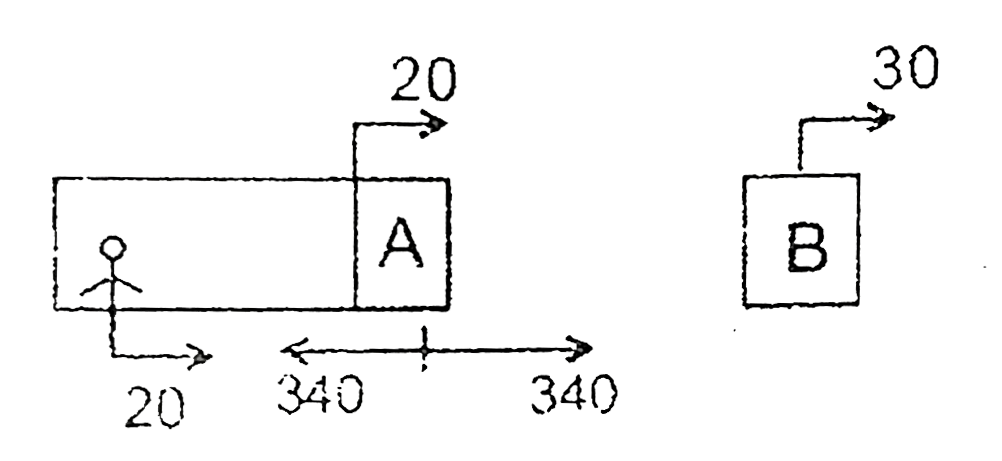Two trains A and B are moving on parallel tracks in opposite direction at same speed of 30ms–1. Just when the engines of the two trains are about to cross, the engine of train A begins to sound a horn. The sound of the horn is composed of components varying in frequency from 900Hz to 1200 Hz. The speed of sound in air is 330ms–1.
(a) Find the frequency spread (range of frequencies) for the sound heard by a passenger in train A.
(b) Find the frequency spread heard by a passenger in train B.
The correct Answer is:(a) 900 Hz to 1200 Hz
(b) 1080 Hz to 1440 Hz
Step by step video, text & image solution for Two trains A and B are moving on parallel tracks in opposite direction at same speed of 30 ms^( –1). Just when the engines of the two trains are about to cross, the engine of train A begins to sound a horn. The sound of the horn is composed of components varying in frequency from 900 Hz to 1200 Hz. The speed of sound in air is 330 ms^( –1). (a) Find the frequency spread (range of frequencies) for the sound heard by a passenger in train A. (b) Find the frequency spread heard by a passenger in train B. by Physics experts to help you in doubts & scoring excellent marks in Class 11 exams.
Updated on:21/07/2023Topper's Solved these Questions
Similar Questions
A toy train in a children amusement park runs on an elliptical orbit having major and minor axis in the ratio of 4:3. The length of the train is exactly equal to half the perimeter of the elliptical track. The train is travelling at a constant speed of 20ms–1. The engine sounds a whistle when its acceleration is minimum. The whistle has a frequency of f0=3460Hz and speed of sound in air is V=330ms–1
(a) What frequency of whistle is received by a passenger in the last compartment of the train?
(b) What frequency of whistle is received by a passenger sitting in the central compartment of the train?
View SolutionTwo trains are moving on two parallel tracks but in opposite directions. A person sitting in the train moving at the speed of 80 km/hr passes the second train in 18 seconds. If the length of the second train is 1000 m, its speed is :
View Solution
Knowledge Check
The engine of a train sound a whistle at frequency v, the frequency heard by a passenger is
A>vB<vC=1vD=vtwo trains AandB moving with speeds 20m/s and 30m/s respectively in the same direction on the same straight track, with B ahesd of A. The engines are at the front ends. The engine of train A blows a long whistle.
Assume that the sound of the whistle is composed of components varying in frequency from f1=800Hz to f2=1120Hz, as shown in the figure. the spread in the frequency (highest frequency - lowest frequency) is thus 320Hz. the speed of sound in still air is 340m/s.
The spread of frequency as observed by the passenger in train B isA(a) 310HzB(b ) 330HzC( c ) 350HzD(d) 290HzTwo trains A and B are moving with speeds 20m/s respectively in the same direction on the same stright track, with B ahead of A. The engines are at the front ends. The engines of train A blows a long whistle.
Assume that the sound of the whistle is composed of components varying in frequency from f1=800Hz to f2=1120Hz, asz shown in figure. The spread in the frequency (highest frequency - lowest frequency) is thus 320Hz. The speed of sound in still air is 340m/s.

The spred of frequency as observed by the passengers in train B isA310HzB330HzC350HzD290Hz
A train A is travelling at a speed of 108 km hr−1 The train approaches another train B standing on the platform.The engine of the train B below its horn. The frequency of the horn as observed by the driver in train A is 504 Hz. The frequency of the horn of train B is (speed of sound = 330 ms−1
View Solutiontwo trains AandB moving with speeds 20m/s and 30m/s respectively in the same direction on the same straight track, with B ahesd of A. The engines are at the front ends. The engine of train A blows a long whistle.
Assume that the sound of the whistle is composed of components varying in frequency from f1=800Hz to f2=1120Hz, as shown in the figure. the spread in the frequency (highest frequency - lowest frequency) is thus 320Hz. the speed of sound in still air is 340m/s.
(5) The distribution of the sound intensity of the whistle as observed by the passengers in train A is best represented by
View Solutiontwo trains AandB moving with speeds 20m/s and 30m/s respectively in the same direction on the same straight track, with B ahesd of A. The engines are at the front ends. The engine of train A blows a long whistle.
Assume that the sound of the whistle is composed of components varying in frequency from f1=800Hz to f2=1120Hz, as shown in the figure. the spread in the frequency (highest frequency - lowest frequency) is thus 320Hz. the speed of sound in still air is 340m/s.
(4) The speed of sound of the whistle is
View SolutionThe driver of a car travelling with speed 30ms−1 towards a hill sounds a horn of frequency 600 Hz. If the velocity of sound in air is 330ms−1, the frequency of reflected sound as heard by driver is
View SolutionThe driver of a car travelling with speed 30ms−1 towards a hill sounds a horn of frequency 600 Hz. If the velocity of sound in air is 330ms−1, the frequency of reflected sound as heard by driver is
View Solution
